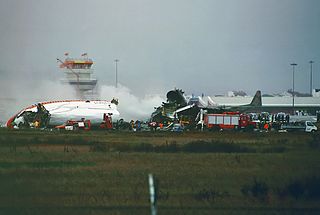The Societé anonyme belge d'Exploitation de la Navigation aérienne, better known by the acronym Sabena or SABENA, was the national airline of Belgium from 1923 to 2001, with its base at Brussels National Airport. After its bankruptcy in 2001, SN Brussels Airlines was formed through a takeover of former subsidiary Delta Air Transport and took over part of Sabena's assets in February 2002, which became Brussels Airlines after a merger with Virgin Express in March 2007. The airline's corporate headquarters were located in the Sabena House on the grounds of Brussels Airport in Zaventem.

Swissair Flight 111 (SR111/SWR111) was a scheduled international passenger flight from John F. Kennedy International Airport in New York City, United States, to Cointrin Airport in Geneva, Switzerland. This flight was also a codeshare flight with Delta Air Lines. On 2 September 1998, the McDonnell Douglas MD-11 performing this flight, registration HB-IWF, crashed into the Atlantic Ocean southwest of Halifax Stanfield International Airport at the entrance to St. Margarets Bay, Nova Scotia. The crash site was 8 kilometres from shore, roughly equidistant from the small fishing and tourist communities of Peggy's Cove and Bayswater. All 229 passengers and crew on board the MD-11 were killed, making the crash the deadliest accident in the history of Swissair and the deadliest accident involving McDonnell Douglas MD-11. It is also the second-deadliest aviation accident to occur in Canada, behind Arrow Air Flight 1285R.

The China National Aviation Corporation was a Chinese airline which was nationalized after the Chinese Communist Party took control in 1949, and merged into the People's Aviation Company of China (中國人民航空公司) in 1952. It was a major airline under the Nationalist government of China.
This is a list of aviation-related events from 1934:
This is a list of aviation-related events from 1948:
This is a list of aviation-related events from 1930:
This is a list of aviation-related events from 1954:
This is a list of aviation-related events from 1978.

On 12 November 1996, Saudia Flight 763, a Boeing 747 en route from Delhi, India, to Dhahran, Saudi Arabia, and Kazakhstan Airlines Flight 1907, an Ilyushin Il-76 en route from Chimkent, Kazakhstan, to Delhi, collided over the village of Charkhi Dadri, around 100 km west of Delhi. The crash killed all 349 people on board both planes, making it the world's deadliest mid-air collision and the deadliest aviation accident to occur in India. The crash was caused by failure of the Kazakh crew to maintain the correct altitude, because of confused dialogue with the tower communicated via the radio operator.

NLM CityHopper Flight 431 refers to a Fokker F-28-4000, registration PH-CHI, that was due to operate an international scheduled Rotterdam–Eindhoven–Hamburg passenger service. On 6 October 1981, the aircraft encountered severe weather on the first leg, minutes after taking off from Rotterdam Airport, and crashed 15 miles (24 km) south-southeast of Rotterdam. All 17 occupants of the aircraft – 13 passengers and 4 crew members– died in the accident.

Martinair Flight 495 was a McDonnell Douglas DC-10 operated by Dutch airline Martinair, that crash-landed in severe weather conditions at Faro Airport, Portugal on 21 December 1992. The aircraft carried 13 crew members and 327 passengers, mainly holidaymakers from the Netherlands. 54 passengers and 2 crew members died. 106 of the other occupants were badly injured.

Southern Airways Flight 242 was a flight from Muscle Shoals, Alabama, to Atlanta, Georgia, with a stop in Huntsville, Alabama. On April 4, 1977, it executed a forced landing on Georgia State Route 381 in New Hope, Paulding County, Georgia, United States, after suffering hail damage and losing thrust on both engines in a severe thunderstorm.

Pulkovo Aviation Enterprise Flight 612 was a scheduled passenger flight operated by Saint Petersburg-based airline Pulkovo Aviation Enterprise, flying from Anapa Airport to Pulkovo Airport in Saint Petersburg. The aircraft crashed in Donetsk Oblast in eastern Ukraine, near the Russian border, on 22 August 2006. All 170 people on board were killed.

Braniff International Airways Flight 352 was a scheduled domestic flight from William P. Hobby Airport in Houston, Texas, United States, to Dallas Love Field in Dallas; on May 3, 1968, a Lockheed L-188A Electra flying on the route, registration N9707C, broke up in midair and crashed near Dawson, Texas, after flying into a severe thunderstorm. It was carrying 5 crew and 80 passengers; there were no survivors. Among those killed was Texas state representative Joseph Lockridge, the first black man to represent Dallas County in the Texas Legislature. Investigation revealed that the accident was caused by the captain's decision to penetrate an area of heavy weather followed by a structural over-stress and failure of the airframe while attempting recovery from loss of control during a steep 180-degree turn executed in an attempt to escape the weather.

The Curtiss T-32 Condor II was a 1930s American biplane airliner and bomber aircraft built by the Curtiss Aeroplane and Motor Company. It was used by the United States Army Air Corps as an executive transport.

On July 28, 1943 American Airlines Flight 63 was flown by a Douglas DC-3, named Flagship Ohio, routing Cleveland-Columbus-Dayton-Cincinnati-Louisville-Nashville-Memphis, that crashed on the Louisville-Nashville sector about 1.6 miles (2.6 km) west of Trammel, Kentucky. The aircraft descended from 200 feet (61 m) until it struck trees, then slid across an open field and stopped in an upright position. Of the 22 people on board, 20 died. The cause of the crash was loss of control due to severe turbulence and violent downdrafts.

The Douglas DC-2 is a 14-passenger, twin-engined airliner that was produced by the American company Douglas Aircraft Company starting in 1934. It competed with the Boeing 247. In 1935, Douglas produced a larger version called the DC-3, which became one of the most successful aircraft in history.












